During our exploration of west Japan, Naoshima Island stood out as one of the unique places to visit. From the incredible outdoor artwork such as the Yellow Pumpkin by Yayoi Kusama to the interesting museums, spending one day in Naoshima (直島町) is a fantastic way to get engrossed with contemporary artwork.
Located in the Seto Inland Sea in the Kagawa Prefecture, Naoshima is a small and quiet island with beautiful views of the blue waters and traditional houses. The island is the perfect place to take a day trip from Okayama, Osaka, or Kyoto since the environment is laid-back and peaceful.
In this Naoshima guide, we’re sharing a one day Naoshima itinerary highlighting the must-see tourist attractions, how to get to Naoshima, how to travel around the island and other helpful tips.
Continue more on what to expect with this Naoshima day trip!
Planning a trip to Japan? Check out our other posts for inspiration:
*Disclaimer: If you’re heading to Japan, please note that this post contains affiliate links. If you click on them and make a purchase, we receive a small commission. There is no additional cost to you. Appreciate the support.
How to Get to Naoshima Island
Depending on your starting location, it can take a while to get to Naoshima. We’re sharing how to get to Naoshima from Okayama (the closest location and highly recommended), Osaka, and Kyoto.
Getting to Naoshima is a bit stressful as it requires some planning. You’ll need to take the train to Uno Station, take the ferry to Naoshima, then figure out your transportation on Naoshima. We’ll share more details below.
From Okayama to Naoshima
It’s recommended to visit Naoshima from Okayama as it’ll be less stressful with transit. We stayed overnight in Okayama and went to Naoshima the next day.
From Okayama Station (岡山駅), take the JR local Uno Line to Uno Station (宇野駅). You can also take the JR Seto-Ohashi Line to go to Chayamachi Station (茶屋町駅) and transfer to the local Uno Line to Uno Station. Both of the routes will take 45 minutes one-way. If you have the Japan Rail (JR) pass, you can use it to cover this part of the transportation.
Click here to save money on your JR pass.
From Uno Station, head to the main street and cross the street. Turn right and walk for five minutes. You’ll see the Uno port on the left side.
This is where you’ll buy your ferry tickets to go to Naoshima. It’s recommended to go to the Miyanoura Port since it’ll be easier to find transportation once you leave the ferry. The other port is Honmura Port which is farther away and not as popular.
You can buy your tickets at the ticket machine. The ticket cost is
- Adults: 300 yen ($2.70 USD) one-way or 570 yen ($5.10) for round-trip
- Children (age 6-12): 150 yen ($1.35) one-way, 300 yen ($2.70) round-trip
- Round-trip tickets are valid for two days.
The ferry departs at least once an hour. The chances of you departing Uno Station and then taking the ferry immediately is not possible with the timing. Therefore, you’ll have some waiting time at the Uno Port.
Click here to see the schedule for Uno to Naoshima and Naoshima to Uno.
The ferry ride is 20 minutes and is a comfortable and smooth ride. You probably won’t get seasick as the ferry is not rocky.
From Osaka to Naoshima
From Osaka Station (大阪駅), take the local Tokaido-Sanyo line to Shin-Osaka Station (新大阪駅). From Shin-Osaka, take the shinkansen to go to Okayama Station. Allocate 1 hour for this portion of the travels.
Follow the instructions above from Okayama Station to Uno Station to Naoshima. Allocate another 45 minutes for the local train and over 20 minutes for the ferry ride and waiting time.
In the end, it’ll take over two hours one-way to get to Naoshima.
From Kyoto to Naoshima
From Kyoto Station (京都駅), take the Tokaido-Sanyo line shinkansen to go to Okayama Station. It’ll take about an hour.
Follow the instructions above on how to get to the ferry from Okayama Station to Uno Station. It’ll take another hour. Similarly to Osaka, you’ll need about two hours for one-way.
How to Get Around Naoshima
There are different ways to travel around Naoshima.
1. Rent a bicycle.
There are several bike shops across from the Naoshima Miyanoura Port where you can rent bicycles. Choose from a single speed, multi-speed, or an electric bicycle. The cost is between 300-1,500 yen ($2.70-$13.50). There are some hills so you may consider an electric bicycle for extra help.
2. Take the local bus.
The local bus travels around the island from Miyanoura Port to Nokyo-mae (Art House Project) to Tsutsuji-so (Benesse House museum area). The bus stop is easy to spot when you exit the ferry as it’s located in the bus loading zone and there is a #2 sign.
The ride is affordable at 100 yen ($.90) per ride for adults and 50 yen ($.45) for children (ages 5-12 years). The bus only accepts coins, but you can ask the driver to exchange a 1,000 yen bill for coins. Check the schedule as the bus departs the Miyanoura Port 1-2 times per hour.
When you’re on the bus, don’t forget to get a copy of the visitor guide which has maps and bus and ferry schedules. Otherwise, there are visitor guides at the Miyanoura Port visitor center.
We chose to take advantage of the local bus since it was easier for us. All we needed to do was check the schedule to make sure that we were on track.
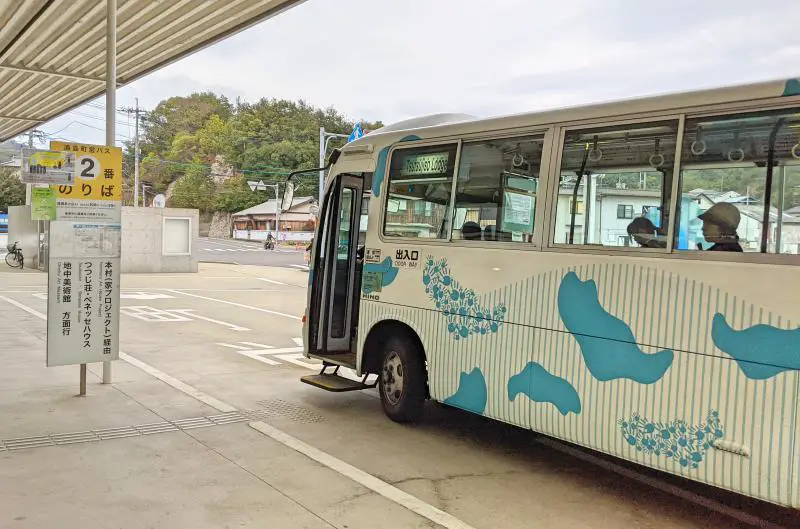
Consider taking the local bus to travel around Naoshima Island. Look for this bus stop and bus when departing from the ferry.
3. Take the free shuttle to Benesse House Museum.
If you decide to head to the Benesse Art area, there is a free shuttle bus from the Tsutsuji-so bus stop to the Benesse House Museum, Lee Ufan Museum, and Chichu Art Museum. The shuttle arrives 1-2 times per hour. Click here to see the schedule and plan your trip accordingly.
4. Walk around the island.
If you prefer to get some exercise, you can walk around the island. Wear comfortable shoes as you’ll be walking for a while. From Miyanoura Port to Honmura area, allocate 30-40 minutes for the walk. It’ll be another 30-40 minutes from Honmura to the Benesse House area.
We did the walk from Honmura to the Miyanoura Port and it was a nice stroll. The walk itself didn’t have any sightseeing attractions but you do come across some creative artwork. The sidewalks are large enough for pedestrians.
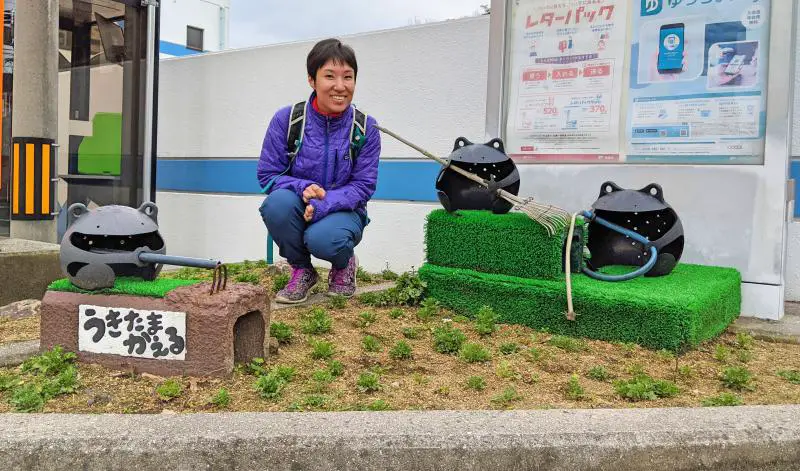
Find adorable artwork during your day on Naoshima Island.
Luggage Storage for your Naoshima Day Trip
If you have luggage or large backpacks and don’t want to carry them on your Naoshima day trip, bring them with you on your ferry ride. Store them at the coin-operated lockers at the Naoshima Miyanoura Port. There are small, medium, and large size lockers to choose from. Cost ranges between 200-500 yen ($1.80-$4.50) depending on the size. We had two larger backpacks and were able to squeeze them into a medium-size locker for 300 yen ($2.70). Don’t lose your key to the locker.
There are coin-operated lockers at the Uno Station, but it only has large size lockers which are 500 yen ($4.50).
What to Do on Your One Day in Naoshima Itinerary
Here are the top things to do in Naoshima during your day trip. Feel free to change around the order of the itinerary based on your interest and schedule.
1. Check out the Yellow Pumpkin and Red Pumpkin sculpture.
Whenever you mention Naoshima, the first thing that comes to people’s minds is the Yellow Pumpkin and Red Pumpkin sculpture with the black dots. It’s a famous sculpture created by the artist, Yayoi Kusama.
The Yellow Pumpkin is in the Tsutsuji-so area so it’s a perfect stop to visit before heading to the Benesse House Museums. It’s a lovely place to take photos since the pumpkin is at the end of the dock area and has a view with the ocean. Please be considerate of the amount of time that you spend at the pumpkin since there will be a line of people waiting to take photos. Follow the bus schedule above or ride your bicycle to get to the Yellow Pumpkin.

The Yellow Pumpkin is an iconic sculpture and needs to be on your Naoshima itinerary.
The Red Pumpkin is next to the Miyanoura Port so you’ll see this when you get off the ferry. We recommend that you save this spot for the end of the day as you may need to catch the bus. The Red Pumpkin is interactive since you can enter inside the pumpkin and pop your head outside of the holes.
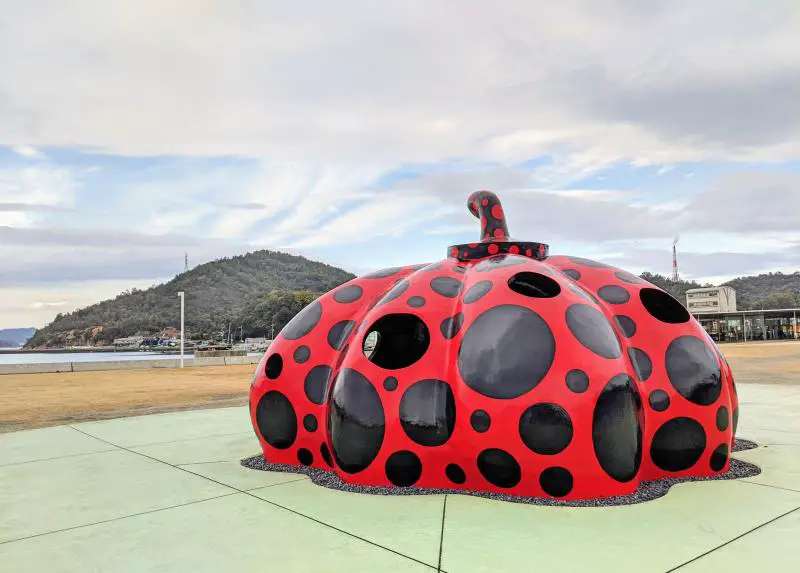
The Red Pumpkin is a must-see attraction during your Naoshima day trip.
2. Explore the Benesse House Museum outdoor artwork.
After you explore the Yellow Pumpkin, head to the other outdoor artwork in the area. They are quirky yet fun to browse around. While this area has a high concentration of artwork, there is art everywhere on the island. It’s a treasure hunt to find them all.
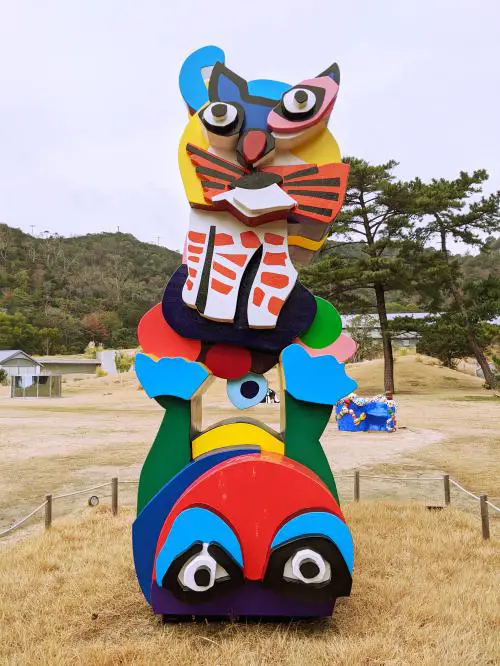 |
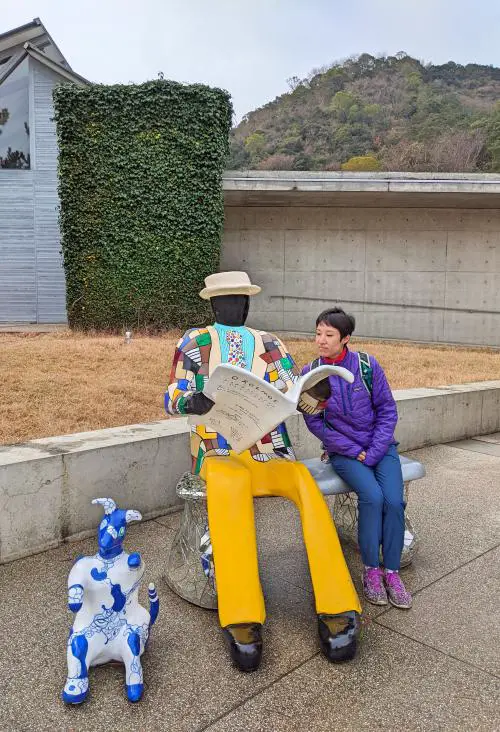 |
3. Explore the Chichu Art Museum.
Take the local bus to Tsutsuji-so stop or your bicycle and head to the three Benesse Art Museums. Chichu Art Museum (地中美術館) is the most popular art museum. The other two are Benesse House Museum and Lee Ufan Museum which are in the same area.
Chichu Art Museum is a contemporary museum that highlights artwork by Claude Monet, Walter De Maria, James Turrell, and Tadao Ando’s building architecture. If you appreciate minimal and simple artwork, then this is the place to visit. If not, then it’s recommended to see the outdoor artwork as they are more exciting and colorful. The museum isn’t large so you can see everything within 30-45 minutes.
When you first head to the museum, you’ll pass by the Chichu Garden which has plants and a pond that looks like a Monet painting. During our visit, the spring plants weren’t in full bloom and the pond didn’t have any lily pads.

Everyone passes by the Chichu Garden on the way to the Chichu Art Museum.
As you enter the museum, you’ll notice the concrete building designed by Tadao Ando. The museum is underground so the building wouldn’t affect the landscape and the views of the island.
The exhibits are on two levels. The Claude Monet area is lovely to see original paintings by the artist. The natural light also brings out the colors of the water lily paintings. You’ll need to take off your shoes to enter the exhibit. We loved the Walter De Maria sculpture of “Time / Timeless / No Time” with the huge 2.2 meters (7.2 feet) diameter sphere with 27 gold-covered wooden trims and the natural lighting. Lastly, the James Turrell artwork was an open area with natural lighting from the ceiling and also art shown by a projector.
There is a cafe and an outdoor area to see the views of the neighboring island. We appreciated the fresh air when we went outside.
Helpful tips for visiting Chichu Art Museum
- Purchase your ticket in advance here. If you visit this museum during the high season, a reservation is highly recommended. Ten minutes before your museum entrance time, you’ll exchange your email ticket for a physical ticket. The museum is strict with the exchange time and will not allow you to exchange them earlier.
- You can purchase tickets on the day of your visit but there isn’t any guarantee that you can visit when you arrive. You may have tickets for later in the day.
- There are coin-operated lockers if you need to store a backpack.
- Photos are not allowed in the museum.
- Take the free shuttle from the Tsutsuji-so bus stop to get to the Chichu Art Museum (last stop).
Address: 3449-1, Naoshima, Kagawa District, Kagawa 761-3110, Japan (〒761-3110 香川県香川郡直島町3449-1)
Opening Hours: 10:00am-6:00pm (March-September), 10:00am-5:00pm (October-February) (Closed on Monday.)
Admission Cost: 2,100 yen ($18.80) adults, free under 15 years old
4. Check out the other museums if you have time.
Depending on your Naoshima itinerary, you can check out the other two museums – Benesse House Museum (ベネッセハウス ミュージアム) and Lee Ufan Museum (李禹煥美術館). You can walk to the other museums from the Chichu Art Museum or take the free shuttle.
We didn’t have a chance to visit these museums as the Chichu Art Museum was enough for the day. The other two museums would be great for those who are staying overnight on the island.
The Benesse House Museum is a contemporary art museum that has paintings, sculptures, photographs, and other unique artwork. The building is designed by Tadao Ando.
Address: Japan, 〒761-3110 Kagawa, Kagawa District, Naoshima, 琴弾地 (〒761-3110 香川県香川郡直島町 琴弾地)
Opening Hours: 8:00am-9:00pm
Admission Cost: 1,050 yen ($9.70) for adults, free under 15 years old and hotel guests
Lee Ufan Museum is a collaboration with Tadao Ando and the artist, Lee Ufan. There are paintings and sculptures from Lee Ufan.
Address: Japan, 〒761-3110 Kagawa, Kagawa District, Naoshima, 字倉浦1390(〒761-3110 香川県香川郡直島町 字倉浦1390)
Opening Hours: 10:00am-6:00pm (March-September), 10:00am-5:00pm (October-February) (Closed on Monday.)
Admission Cost: 1,050 yen ($9.70) for adults, free under 15 years old and hotel guests
5. Lunch around the Honmura area.
Honmura is a fabulous area to stop for lunch. There are various restaurants to try from Japanese, pizza, and cafes. The visitor guide highlights the restaurants in the area. To get here, take the local bus from Tsutsuji-so stop to Nokyo-mae bus stop.
Since we visited Naoshima in January, many of the restaurants were closed. We wanted to try Apron Cafe but it was closed for renovation, so we went to Genmai-Shinshoku Aisunao for vegan food. Guests have the chance to sit on the tatami mats. The lunch meal came with special rice, tofu, pickles, miso soup. It’s reasonable at 1000 yen ($9.20) each. We felt that the meal was good but didn’t pop with the flavor.
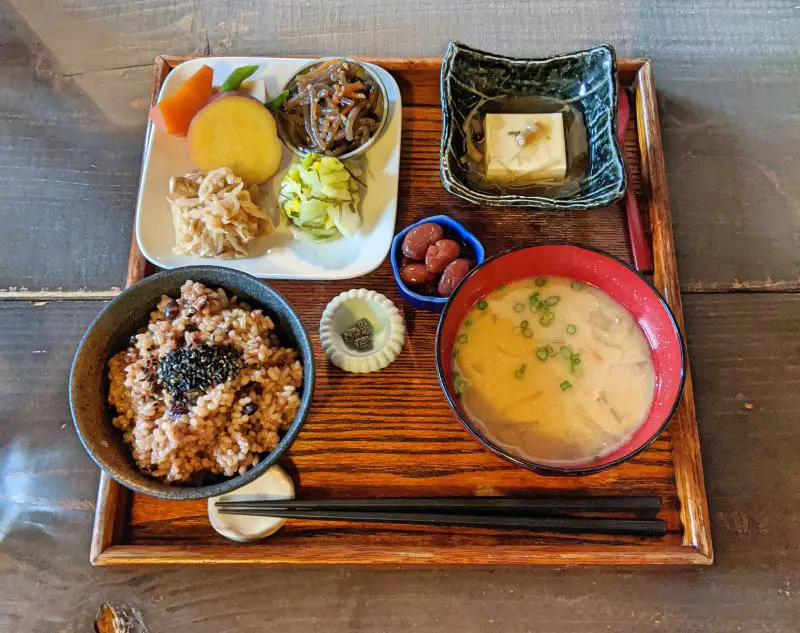
Genmai-Shinshoku Aisunao is one of the restaurants in Naoshima’s Honmura area to try.
One place that looked interesting in the visitor guide was Shimacoya which had a giant pudding meal set. We didn’t have a chance to try it as we wanted to continue with our day.
6. Explore the Art House Project.
Visiting the Art House Project is a great way to spend the afternoon on Naoshima. There are seven art exhibits located in restored 400 year old houses in the Honmura area. You wouldn’t notice these art galleries as they blend in with the other houses.
Six exhibits are available to visit on a multi-site ticket or individual ticket, while Art House Project Kinza is a separate admission and requires a reservation. We recommend that you see the six exhibits since they are very different from each other. If you do decide to visit the six exhibits, you can visit the exhibits in any order that you’d like. Although, it’s recommended to go to Minamidera first since it tends to have a longer wait. Every place will place a stamp in your ticket brochure to mark your visit. The sites are within walking distance.
The six exhibits are:
- Kadoya by Tatsuo Miyajima
- Minamidera by James Turrell
- Go’o Shrine by Hiroshi Sugimoto
- Ishibashi by Hiroshi Senju
- Gokaisho by Yoshiro Suda
- Haisha by Shinro Ohtake
We don’t want to spoil the surprise for these artworks but we enjoyed the Minamidera where you’ll spend some time in the dark and Haisha for the funky artwork including a Statue of Liberty.
On a side note, the Honmura area is adorable to walk through and take photos of the traditional houses and alleyway.
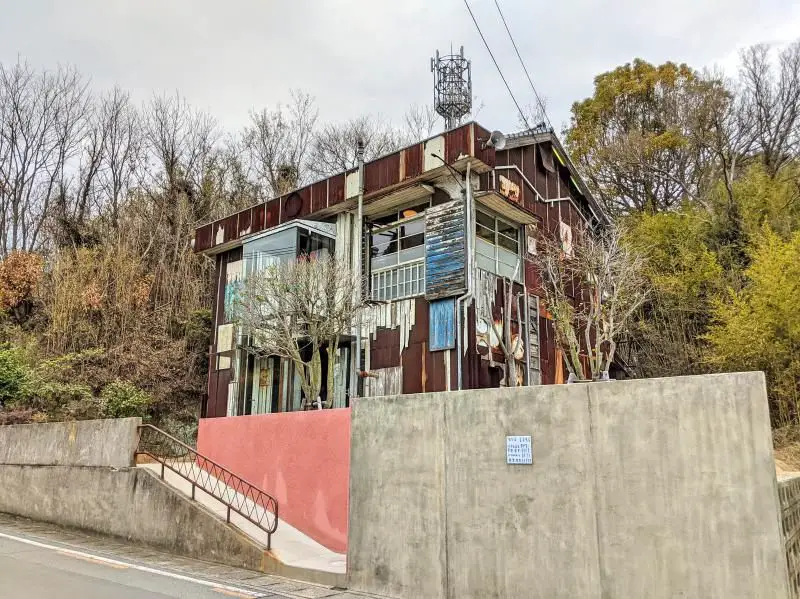
Haisha is one of the exciting art exhibits to visit in the Art House Project. It’s one of our favorite exhibits to see during your one day in Naoshima.
Address: Sites are located in the Honmura area
Opening Hours: 10:00am-4:30pm (Closed on Monday.)
Admission Cost:
- General admission for 6 sites: 1,050 yen ($9.50) adults (excludes the Art House Project Kinza), free under 15 years old
- General admission for 1 site only: 420 yen ($3.80)
- Purchase tickets at the Honmura Lounge and Archive (850-2, Naoshima, Kagawa District, Kagawa 761-3110, Japan / 〒761-3110 香川県香川郡直島町850-2). You can also take a rest break and do some souvenir shopping at this place too.
Where to Stay in Naoshima
If you decide to stay overnight in Naoshima, here are several accommodations to consider based on the positive reviews.
Click here to see more Naoshima accommodation options.
Guesthouse Roji to Akari – This guesthouse is an affordable option to stay in Naoshima. Visitors like the location as it’s in the Honmura area and staying in a traditional house. It’s close to the Art Project House exhibits. Cost is between $70-$80 per room for 2 person occupancy or $30 per person for a bed in a mixed dorm.
Read more and make a reservation for Guesthouse Roji to Akari here.
Wright Style – This hotel is close to the Benesse House Museum area. Visitors enjoy the clean rooms, delicious breakfast, and the location as the bus stop is nearby. Cost is between $130-$190 per room for 2 person occupancy.
Check availability and make a reservation for Wright Style here.
Benesse House Hotel – This is a hotel that connects with the Benesse House Museum. It’s a luxury option since you get the chance to view out into the park or beach view. Cost starts at $390 per room for 2 person occupancy.
Make a reservation for Benesse House Hotel here.
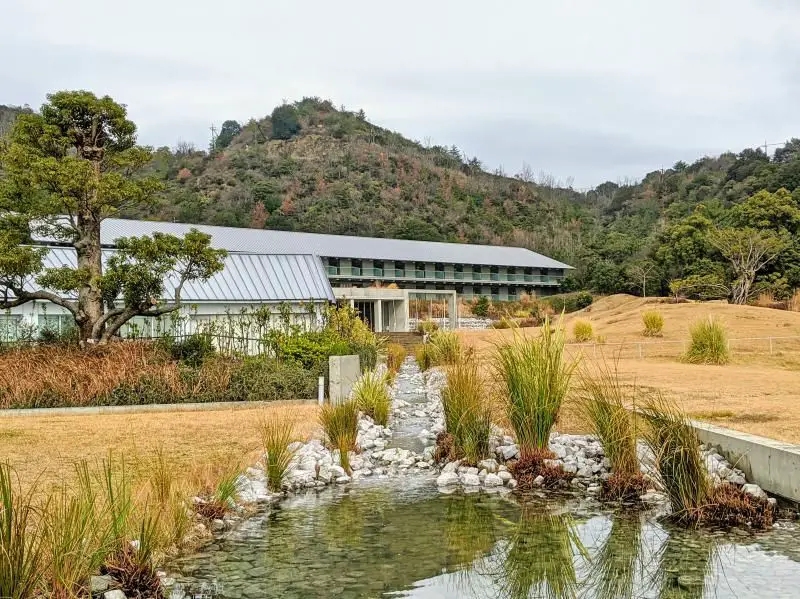
You can stay in one of these luxury rooms at the Benesse House Hotel if staying overnight in Naoshima.
Final Thoughts about Naoshima Day Trip
It’s the end of your one day at Naoshima Island. Whew! You saw quite a few art exhibits for the day. We hope you enjoyed seeing the various art on the gorgeous island! Even if you’re not an art fan, there are some unique exhibits that will get you thinking and spark conversation.
Now it’s time to return home. Depending on your starting location, you’ll head back to Okayama, Osaka, Kyoto, or continue to the next nearest city, Hiroshima.
Want to save this post? Pin it to your Japan Pinterest board.
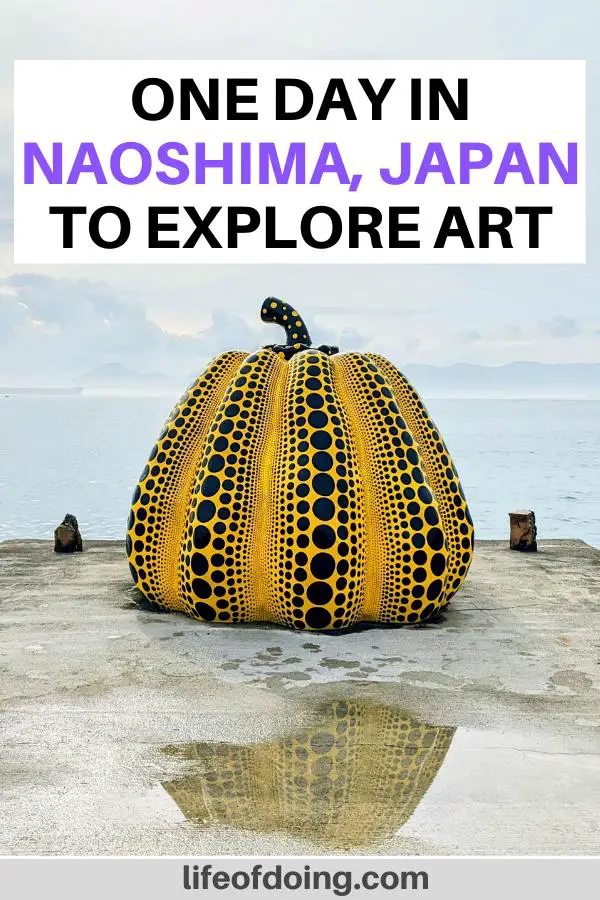 |

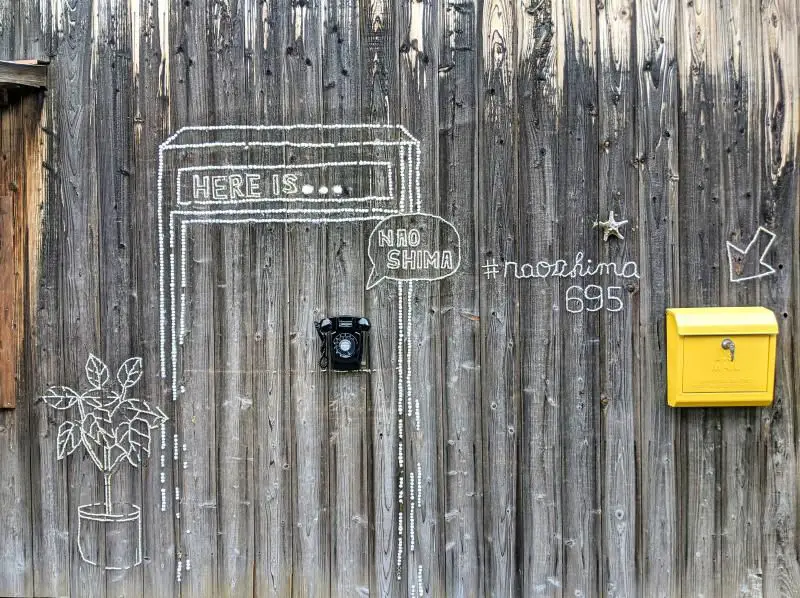
4 comments
Ok, so apparently you can go around by bike! I have always thought that Naoshima is super crowded, and you can’t get around so easily. I love cycling! Would be cool to see all these things without renting a car.
A bicycle is a great idea to travel around Naoshima Island. Just have to watch out for some hills when heading up to Benesse Art Museums.
I love how much you were able to stay outdoors and explore. I also like taking public transportation, walking, and riding bicycles when I’m in a new destination. This looks like a beautiful city to explore!
You’ll love visiting Naoshima Island on a future trip to Japan!